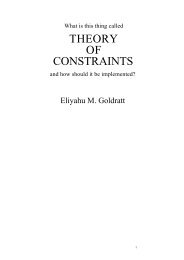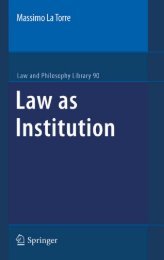Making of a German Constitution : a Slow Revolution
Making of a German Constitution : a Slow Revolution
Making of a German Constitution : a Slow Revolution
Create successful ePaper yourself
Turn your PDF publications into a flip-book with our unique Google optimized e-Paper software.
Undermining Absolutism • 147founder <strong>of</strong> the movement. While Savigny had emphasized the place <strong>of</strong> Roman legalscience, a <strong>German</strong> system would come from the ‘flesh and blood <strong>of</strong> <strong>German</strong> life’. 101Jagemann also explained the important place <strong>of</strong> the Lübeck <strong>German</strong>istentag, whereChrist had issued his original call for a unified code, and emphasized that this wasparticularly important relative to family law and marital relations. 102 Eduard Pape,who would head the first BGB Commission before his death in 1888 also publishedan article in the same edition. 103These legal infrastructural developments and the constant work <strong>of</strong> the <strong>German</strong> legalworld kept constitutional transformation moving forward. Indeed, in 1862, well beforethe founding <strong>of</strong> the North <strong>German</strong> Confederation in 1866, a commission was set up tobegin work on a procedural code for all the <strong>German</strong> states and under the leadership <strong>of</strong>Hanover’s liberal justice minister, Adolf Leonhardt, who was the lead editor for the1850 legislation. In 1867, in an effort to appease Hanover, Bismarck secured Leonhardt’sappointment to the position <strong>of</strong> Minister <strong>of</strong> Justice for Prussia, and the earlierwork was absorbed in the planned code for the Confederation. In the end, Leonhardtwould head the national procedure code commission for the Reich after 1871.Commercial LawAlthough commercial law was a critical area <strong>of</strong> private law, it is not the major focus<strong>of</strong> this study. However, a few comments are in order. The consolidation <strong>of</strong> areas <strong>of</strong>law dealing with business and commercial matters followed a pattern <strong>of</strong> developmentsimilar to that <strong>of</strong> procedural reform. 104 Whereas legal scholars for a long time suggestedthat study and research in the field <strong>of</strong> commercial law was neglected until the1840s, this view may also now be reconsidered. 105 Mittermaier’s system dedicatedconsiderable attention to the legal history <strong>of</strong> commercial, exchange and maritimelaw. 106 Following this general history, legal research reflected not only the searchfor data and the recovery <strong>of</strong> local customary arrangements, but followed local legaldevelopments in strong commercial centres.This was first evident regarding exchange law. Friedrich Bodungen published hisDas königlich-hannoverische Wechselrecht in alphabetischer Ordnung in 1824. 107Jacob Pestalutz <strong>of</strong>fered a comparative study, Abhandlung über das ZüricherischeWechselrecht, mit Vergleichung der Augsburger, Sct. Galler und Basler Wechselordnung(1827). 108 The same year, Heinrich Daniels attempted to delineate the basic legalprinciples <strong>of</strong> exchange law in his Grundsätze des Wechselrechts. 109 Hermann Rothschildtproduced the seminal study on the old Hansestadt <strong>of</strong> Braunschweig. 110 HisDie bei dem Verkehre mit Wechseln zu beobachtenden Formen nach gemeinem Rechteund der Braunschweigischen Wechselordnung appeared in 1841. 111 Eduard Souchaystudied Frankfurt in his Anmerkungen zu den Wechsel-Gesetzen der Freien StadtFrankfurt, mit besonderer Bezugnahme auf die <strong>of</strong>fizielle Ausgabe der Wechselordnung




